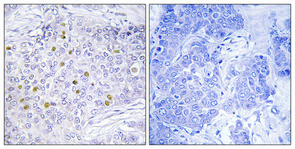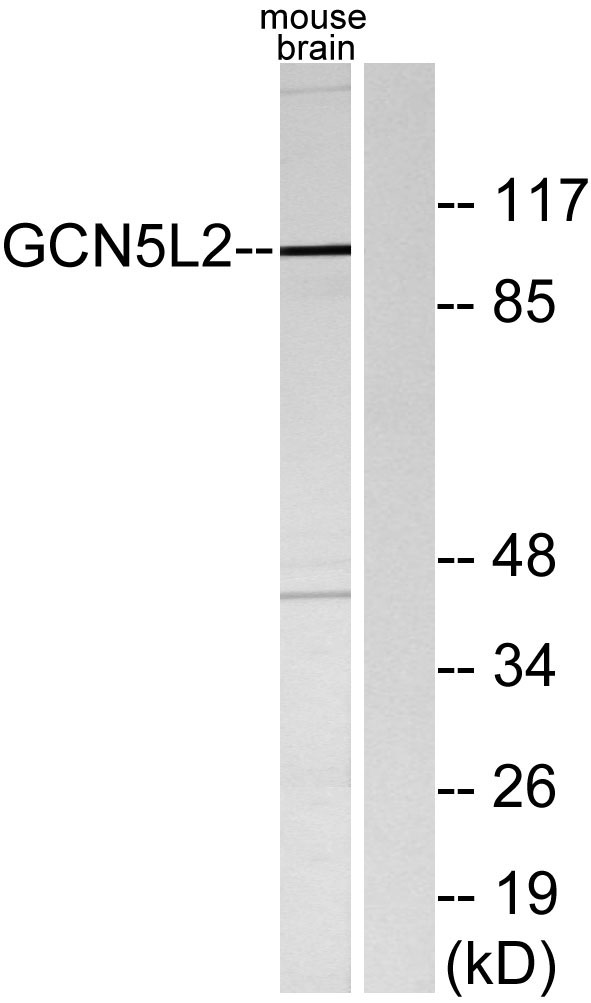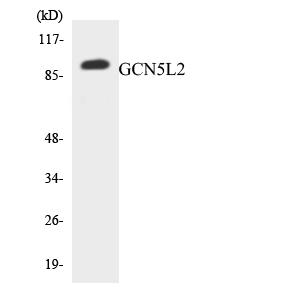GCN5 Polyclonal Antibody
- Catalog No.:YT1875
- Applications:WB;IHC;IF;ELISA
- Reactivity:Human;Mouse
- Target:
- GCN5
- Fields:
- >>Viral life cycle - HIV-1;>>Notch signaling pathway;>>Thyroid hormone signaling pathway;>>Human T-cell leukemia virus 1 infection;>>Viral carcinogenesis
- Gene Name:
- KAT2A
- Protein Name:
- Histone acetyltransferase KAT2A
- Human Gene Id:
- 2648
- Human Swiss Prot No:
- Q92830
- Mouse Gene Id:
- 14534
- Mouse Swiss Prot No:
- Q9JHD2
- Immunogen:
- The antiserum was produced against synthesized peptide derived from human GCN5L2. AA range:691-740
- Specificity:
- GCN5 Polyclonal Antibody detects endogenous levels of GCN5 protein.
- Formulation:
- Liquid in PBS containing 50% glycerol, 0.5% BSA and 0.02% sodium azide.
- Source:
- Polyclonal, Rabbit,IgG
- Dilution:
- WB 1:500 - 1:2000. IHC 1:100 - 1:300. ELISA: 1:20000.. IF 1:50-200
- Purification:
- The antibody was affinity-purified from rabbit antiserum by affinity-chromatography using epitope-specific immunogen.
- Concentration:
- 1 mg/ml
- Storage Stability:
- -15°C to -25°C/1 year(Do not lower than -25°C)
- Other Name:
- KAT2A;GCN5;GCN5L2;HGCN5;Histone acetyltransferase KAT2A;General control of amino acid synthesis protein 5-like 2;Histone acetyltransferase GCN5;HsGCN5;Lysine acetyltransferase 2A;STAF97
- Observed Band(KD):
- 100kD
- Background:
- KAT2A, or GCN5, is a histone acetyltransferase (HAT) that functions primarily as a transcriptional activator. It also functions as a repressor of NF-kappa-B (see MIM 164011) by promoting ubiquitination of the NF-kappa-B subunit RELA (MIM 164014) in a HAT-independent manner (Mao et al., 2009 [PubMed 19339690]).[supplied by OMIM, Sep 2009],
- Function:
- somitogenesis, regionalization, chromatin organization, chromatin remodeling, transcription, transcription, DNA-dependent, regulation of transcription, DNA-dependent, regulation of transcription from RNA polymerase II promoter,transcription from RNA polymerase II promoter, protein amino acid acetylation, pattern specification process,embryonic development ending in birth or egg hatching, anterior/posterior pattern formation, chromatin modification,covalent chromatin modification, histone modification, histone acetylation, histone deubiquitination, protein deubiquitination, RNA biosynthetic process, segmentation, chordate embryonic development, protein amino acid acylation, histone H3 acetylation, regulation of transcription, regulation of RNA metabolic process, chromosome organization, protein modification by small protein removal, protein modification by small protein conjugation or rem
- Subcellular Location:
- Nucleus . Chromosome . Cytoplasm, cytoskeleton, microtubule organizing center, centrosome . Mainly localizes to the nucleus (PubMed:27796307). Also localizes to centrosomes in late G1 and around the G1/S transition, coinciding with the onset of centriole formation (PubMed:27796307). .
- Expression:
- Expressed in all tissues tested.
- June 19-2018
- WESTERN IMMUNOBLOTTING PROTOCOL
- June 19-2018
- IMMUNOHISTOCHEMISTRY-PARAFFIN PROTOCOL
- June 19-2018
- IMMUNOFLUORESCENCE PROTOCOL
- September 08-2020
- FLOW-CYTOMEYRT-PROTOCOL
- May 20-2022
- Cell-Based ELISA│解您多样本WB检测之困扰
- July 13-2018
- CELL-BASED-ELISA-PROTOCOL-FOR-ACETYL-PROTEIN
- July 13-2018
- CELL-BASED-ELISA-PROTOCOL-FOR-PHOSPHO-PROTEIN
- July 13-2018
- Antibody-FAQs
- Products Images

- Western Blot analysis of various cells using GCN5 Polyclonal Antibody diluted at 1:1000 cells nucleus extracted by Minute TM Cytoplasmic and Nuclear Fractionation kit (SC-003,Inventbiotech,MN,USA).
.jpg)
- Western Blot analysis of Hela cells using GCN5 Polyclonal Antibody diluted at 1:1000 cells nucleus extracted by Minute TM Cytoplasmic and Nuclear Fractionation kit (SC-003,Inventbiotech,MN,USA).

- Immunohistochemical analysis of paraffin-embedded Human breast cancer. Antibody was diluted at 1:100(4° overnight). High-pressure and temperature Tris-EDTA,pH8.0 was used for antigen retrieval. Negetive contrl (right) obtaned from antibody was pre-absorbed by immunogen peptide.

- Western blot analysis of lysates from mouse brain, using GCN5L2 Antibody. The lane on the right is blocked with the synthesized peptide.

- Western blot analysis of the lysates from RAW264.7cells using GCN5L2 antibody.



